Influence of seasonal environmental variables on the distribution of presumptive fecal Coliforms around an Antarctic research station
- PMID: 12902283
- PMCID: PMC169114
- DOI: 10.1128/AEM.69.8.4884-4891.2003
Influence of seasonal environmental variables on the distribution of presumptive fecal Coliforms around an Antarctic research station
Abstract
Factors affecting fecal microorganism survival and distribution in the Antarctic marine environment include solar radiation, water salinity, temperature, sea ice conditions, and fecal input by humans and local wildlife populations. This study assessed the influence of these factors on the distribution of presumptive fecal coliforms around Rothera Point, Adelaide Island, Antarctic Peninsula during the austral summer and winter of February 1999 to September 1999. Each factor had a different degree of influence depending on the time of year. In summer (February), although the station population was high, presumptive fecal coliform concentrations were low, probably due to the biologically damaging effects of solar radiation. However, summer algal blooms reduced penetration of solar radiation into the water column. By early winter (April), fecal coliform concentrations were high, due to increased fecal input by migrant wildlife, while solar radiation doses were low. By late winter (September), fecal coliform concentrations were high near the station sewage outfall, as sea ice formation limited solar radiation penetration into the sea and prevented wind-driven water circulation near the outfall. During this study, environmental factors masked the effect of station population numbers on sewage plume size. If sewage production increases throughout the Antarctic, environmental factors may become less significant and effective sewage waste management will become increasingly important. These findings highlight the need for year-round monitoring of fecal coliform distribution in Antarctic waters near research stations to produce realistic evaluations of sewage pollution persistence and dispersal.
Figures
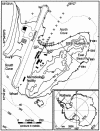
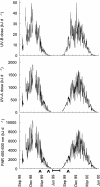
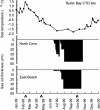

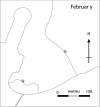
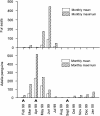

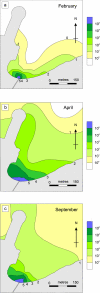

Similar articles
-
Effect of Antarctic solar radiation on sewage bacteria viability.Water Res. 2005 Jun;39(11):2237-44. doi: 10.1016/j.watres.2005.04.011. Water Res. 2005. PMID: 15927228
-
Distribution of enteric bacteria in Antarctic seawater surrounding a sewage outfall.Water Res. 1993 Apr;27(4):645-50. doi: 10.1016/0043-1354(93)90174-g. Water Res. 1993. PMID: 11537610
-
Sunlight inactivation of fecal bacteriophages and bacteria in sewage-polluted seawater.Appl Environ Microbiol. 1999 Aug;65(8):3605-13. doi: 10.1128/AEM.65.8.3605-3613.1999. Appl Environ Microbiol. 1999. PMID: 10427056 Free PMC article.
-
Distribution of sewage pollution around a maritime Antarctic research station indicated by faecal coliforms, Clostridium perfringens and faecal sterol markers.Environ Pollut. 2004;127(3):315-21. doi: 10.1016/j.envpol.2003.09.004. Environ Pollut. 2004. PMID: 14638291
-
Ecology of southern ocean pack ice.Adv Mar Biol. 2002;43:171-276. doi: 10.1016/s0065-2881(02)43005-2. Adv Mar Biol. 2002. PMID: 12154613 Review.
Cited by
-
Effects of UV Radiation on the Chlorophyte Micromonas polaris Host-Virus Interactions and MpoV-45T Virus Infectivity.Microorganisms. 2021 Nov 25;9(12):2429. doi: 10.3390/microorganisms9122429. Microorganisms. 2021. PMID: 34946033 Free PMC article.
-
Spatial Variation and Survival of Salmonella enterica Subspecies in a Population of Australian Sleepy Lizards (Tiliqua rugosa).Appl Environ Microbiol. 2015 Sep 1;81(17):5804-11. doi: 10.1128/AEM.00997-15. Epub 2015 Jun 19. Appl Environ Microbiol. 2015. PMID: 26092451 Free PMC article.
-
Assessment of pathogenic bacteria in water and sediment from a water reservoir under tropical conditions (Lake Ma Vallée), Kinshasa Democratic Republic of Congo.Environ Monit Assess. 2014 Oct;186(10):6821-30. doi: 10.1007/s10661-014-3891-6. Epub 2014 Jul 1. Environ Monit Assess. 2014. PMID: 24981879
-
Untangling unexpected terrestrial conservation challenges arising from the historical human exploitation of marine mammals in the Atlantic sector of the Southern Ocean.Ambio. 2023 Feb;52(2):357-375. doi: 10.1007/s13280-022-01782-4. Epub 2022 Sep 1. Ambio. 2023. PMID: 36048407 Free PMC article. Review.
-
Microbial communities and immigration in volcanic environments of Canary Islands (Spain).Naturwissenschaften. 2008 Apr;95(4):307-15. doi: 10.1007/s00114-007-0330-3. Epub 2007 Dec 11. Naturwissenschaften. 2008. PMID: 18071667
References
-
- Anonymous. 1994. The microbiology of water 1994. Part 1-drinking water. Methods for the examination of waters and associated materials. Report on public health and medical subjects no. 71. Her Majesty's Stationery Office, London, United Kingdom.
-
- Antarctic Treaty Consultative Parties. 1991. Protocol on Environmental Protection to the Antarctic Treaty. CM 1960. Her Majesty's Stationery Office, London, United Kingdom.
-
- Baleux, B., A. Caro, J. Lesne, P. Got, S. Binard, and B. Delpeuch. 1998. Survie et maintien de la virulence de Salmonella typhimurium VNC exposee simultanement a trios facteurs stressants experimentaux. Oceanol. Acta 21:939-950.
Publication types
MeSH terms
Substances
LinkOut - more resources
Full Text Sources
Medical
Miscellaneous

